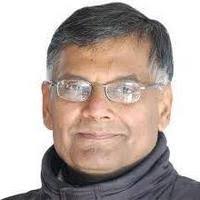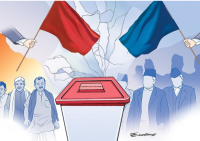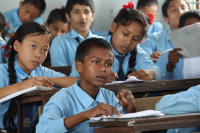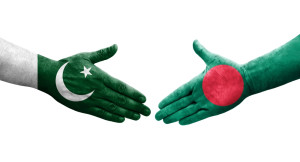Columns
Frayed coattails of Uncle Sam
If the US proposes to facilitate the financing of Nijgadh, it will be difficult to refuse the offer.
CK Lal
Up until the late 1970s, there was so little traffic on the Ring Road that the engineers given the responsibility of maintaining the highway could be heard complaining that they had been saddled with a white elephant. Just off the junction where the Kalanki underpass has recently been built—once again with Chinese assistance—a strip of grassland overlooked the stretch of paddies.
Cattle grazed in the open field of Syuchatar. The airstrip that had existed on the land had been erased out of public memory within a decade of cessation of its operations.
The Syuchatar airstrip was designed for short take-off and landing (STOL) military aircraft and multipurpose helicopters. It’s stated purpose was perhaps to keep the United States Embassy, its operational missions and their powerful allies well-supplied with bags of cornflakes, barrels of pork, rolls of toilet paper, cartons of dental floss and subscription copies of The New Yorker. That the airstrip may also have been used to ferry things other than the food and clothing for the Khampa warriors in Mustang and beyond has seldom been formally acknowledged.
Once ping-pong diplomacy began, Henry Kissinger made his secret trip to Beijing, and President Richard Nixon met Chairman Mao Zedong in “the week that changed the world”, Tibetan fighters were turned into what has been aptly termed in a book as the Orphans of the Cold War.
It is not known whether the Americans continued using the airstrip to transport fresh cheesecakes and aged wines from their Kolkata consulate directly through the airstrip under their control, but it fell into disuse soon after the Nepal Army flushed out Khampa warriors from their hideouts in the mountains with the consent of the US and the guidance of the Chinese.
Land power ambitions
The travails of Tibetans, the trans-Himalayan adventurism of the US Central Intelligence Agency (CIA), the complicity of the Nepali authorities in the exercise of fermenting trouble on foreign soil and the loads of money some brokers and fixers of Kathmandu made during the decade are forgotten stories of the late 1960s. The lore of the hippy wave in the early 1970s pushed the unfortunate Khampa warriors out of sight and out of mind.
Cold War II is likely to be slightly different than the last one. Intelligence will continue to be important, but almost everyone will have access to equally precise data from multiple satellites encircling different orbits. Remote analysis can be done from anywhere in the world. However, feet on the ground requiring dependable supply lines will continue to be as decisive as it was when men on horseback battled it out with their swords.
Nepal needs an airport capable of handling large cargo airplanes for its military to retain the newly-acquired designation of being a “land power”. And whenever the Nepali military desires something, an all-party consensus quickly develops to fulfil its wish.
Soon after the Supreme Court had given the full text of its verdict constraining Nijgadh airport, almost all top leaders of the ruling coalition trooped to the proposed site. Along with Prime Minister Sher Bahadur Deuba, top leaders of the ruling coalition such as Pushpa Kamal Dahal, Madhav Kumar Nepal, Upendra Yadav and Durga Poudel declared in unison that the humongous airport will be built right on the spot that the Supreme Court had ruled to reconsider.
Justifications for Nijgadh are convincing. Tribhuvan International Airport (TIA) in Kathmandu is indeed overcrowded. The saucer shape of the valley does make landing and take-off a little difficult. Acquiring more land at the existing site to add or lengthen its runways, expand or add parking bays or even build more modern ground facilities is almost impossible in the built-up area of a metropolitan city. The most effective way of keeping TIA safe and functional is to reduce its load.
The soon-to-be operational Pokhara International Airport will at best be a supplementary facility and not an alternative to TIA. The same is true for the boutique airport at Bhairahawa that has been given international status. A substitute and supplementary airport for Kathmandu has to be located somewhere along the Simra entry point. Relations with India being what they are, chances are rather slim that New Delhi will permit the use of additional entry points anytime soon.
The proposed site at Nijgadh has also a few other things going. The airspace required for ascending and descending for most aircraft falls well within Nepali territory. Even though extremely slow, the construction of a “fast track” connecting the capital city with the southern plains is in progress. However, the judiciary has taken various intended and unintended consequences of a gigantic airport in the jungle to impose plausible restrictions.
Some of the concerns are fairly obvious. Nothing can justify cutting down millions of trees in the wild and ecologically fragile flatlands of the Chure foothills that strain debris from flowing down to the plains. The wilderness also slows down the monsoon flow and functions as a sump to recharge groundwater.
The biodiversity of the region is irreplaceable. Commercial forests can be planted, but jungles that nurture nature take centuries to evolve. Whether one plants one or 100 for every fallen tree, it will be impossible to restore the ecological balance in the near term.
The verdict of the Supreme Court also suggests a possible solution: Since the no-harm rule will imply the cancellation of the entire project, it will be prudent to let experts come up with fresh proposals that cause minimum damage. Like a broken clock that gives correct time twice a day, the tottering judicial system of Nepal sometimes surprises its critics with wise verdicts.
Geo-economic consequences
Leaving aside ecological and sustainability concerns, mega projects make even less social and economic sense in technologically underdeveloped and resource-poor countries. The "beg, borrow or steal, but make it big" developmental dreams of egocentric rulers do benefit a clutch of bankers, brokers, builders and bureaucrats; but the price the populace has to pay for the extravagance is often immense.
The Burmese invested a fortune in an international airport at their purpose-built city in the middle of nowhere; it lies empty for most of the year. The supposed game-changer of tourism in Sri Lanka has saddled it with the “emptiest international airport of the world”.
Nijgadh can’t be built with Nepal’s own limited resources. Apart from debt-trap worries, funding from the Belt and Road Initiative (BRI) will further alienate New Delhi. Whether it’s the Chinese lobbying against Indian involvement or the Indians opposing Chinese initiatives, the US turns out to be the winner of diplomatic games in Kathmandu.
There is a reason Beijing and New Delhi are equally distrustful of shenanigans of Nepali politicos of all hues. Chances of Nijgadh actually being built don’t look too bright at the moment. But if Uncle Sam proposes to facilitate the financing of a multi-use airport, it will be extremely difficult for the cash-strapped government to refuse the offer irrespective of its consequences. The State Partnership Programme (SPP) saga isn’t yet over.




 7.12°C Kathmandu
7.12°C Kathmandu















